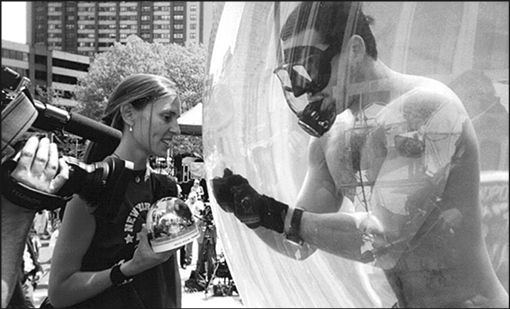BY ALYSSA GIACHINO
The regular crowd is gathered at The Cubbyhole, the consummate Village neighborhood bar. Women and men sip cocktails, a lesbian couple share a kiss, and a gentle snowfall gathers on the antique cash register at the bar.
The figures in the scene are about 1 inch tall, enclosed under the plexiglass dome of a snow globe, created by artist Tressa Octave in homage to her favorite New York bar.
“It’s always been a place that felt comfortable in a really huge city — it’s really consistent,” Octave said, who has visited the bar on and off for more than 10 years. “You always meet somebody interesting and people are approachable.”
Octave presented the globe to the bar’s owner, Tanya Saunders, as a birthday gift last month to thank her for having such a welcoming place.
In 1994, Saunders opened The Cubbyhole, at 281 W. 12th St. in Greenwich Village, and has made it a welcoming space, even if patrons suffer slight sensory overload due to the kaleidoscope of colors and shapes dangling from the ceiling.
“I was trying to incorporate her love of animals and that whole festive, colorful feeling,” Octave said of her globe. It includes details from the bar like the red stools, the flagstone floor and, naturally, the colorful fish on the ceiling.
Saunders was thrilled with the present.
“It’s wonderful that people still take the time to give a truly meaningful gift, a gorgeous gift and amazing gift,” she said. “She picked up every detail. She sculpted the chairs by hand.”
The miniature Cubbyhole is just one of more than a dozen water globes Octave has created over the last five years. She has long been interested in making art accessible, and was inspired to make snow globes by family road trips from her childhood, but she wanted to manipulate the classic Americana tchotchke.
She earned a museum education degree at the Massachusetts College of Art, and worked for the Boston Museum of Fine Arts creating curriculum for school kids. But she was always bothered by the obligatory distance between viewers and art.
“Being trained in high art, art was always something that was unapproachable,” she said. She wanted to “create these little sculptures that people didn’t feel intimidated by and could go up and touch.”
However, the scenes she creates are not the usual insipid road-stop souvenirs.
In the wake of Hurricane Katrina, Octave made a snow globe called “New Orleans” in which people wave from the roof of a miniature house painted with the message “Save Us,” while a Federal Emergency Management Agency helicopter hovers above, outside the globe.
Another, entitled “Lesbian Second Date,” has two women wearing bridal gowns with a moving truck in the background, a reference to an enduring joke about the intensity of lesbian relationships.
“I tried to base it on the most traditional, most simple, most American globe you can find,” Octave said. She painted a standard blue-sky background and placed the figures facing forward, flanked by a cat and a baby for adoption.
The globe’s conventional setup is a pithy representation of the complications around gay marriage, gay parenting and commitment. Though not all Octave’s pieces are as simple in their design, their function is similar to that of political cartoons, which use minimal words and straightforward images to communicate a message.
Octave works from her Upper East Side apartment. Her studio consists of her kitchen table, which is frequently covered with gobs of paint, a noxious waterproof glue substance and miniature plastic hobby-shop figurines.
“Living in New York, it’s not too obtrusive to set it all up and break it all down,” she said.
She shares her kitchen table, and the apartment, with her partner of 13 years. However, she said their second date had no resemblance to the lesbian snow globe.
Dental instruments have proved invaluable for shaping and placing the tiny figures on the circular base, which has a 5-inch diameter. Octave said she worked as a dental assistant to help pay for college, and kept some instruments around. She also uses tweezers to affix an arm or leg to a torso to give a figure the desired pose.
She pays meticulous attention to scale and proportion, which played a large role in the globe she created for stuntman David Blaine during his seven-day stint in a spherical water tank outside Lincoln Center a year ago.
When Octave heard about his “drowned alive” stunt, she knew she had to create a globe miniature Blaine in an orb surrounded by people snapping photos and ogling, who themselves are immersed in water and encased in the snow globe.
While submerged in the tank, Blaine interacted with the public through the thick glass using a chalkboard, which is included in the miniature version. Due to light refraction, Blaine appeared 33 percent larger than his actual size, a detail Octave was careful to re-create to scale.
She rushed down to Lincoln Center to share the globe with him, and Blaine admired her work from inside his tank. Once he emerged, Octave handed him the snow globe as a gift, declining his offer to pay.
Octave has learned through trial and error which materials resist mold and which paints retain their color underwater. The water is a blend of bleach, detergent, and distilled water, which won’t produce mold, and keeps the snowflakes from clumping together. A single snow globe can take up to 60 hours to make, she said.
“The final thing is putting the water in and praying,” she said.
For more information on Tressa Octave and her water globes, visit



































